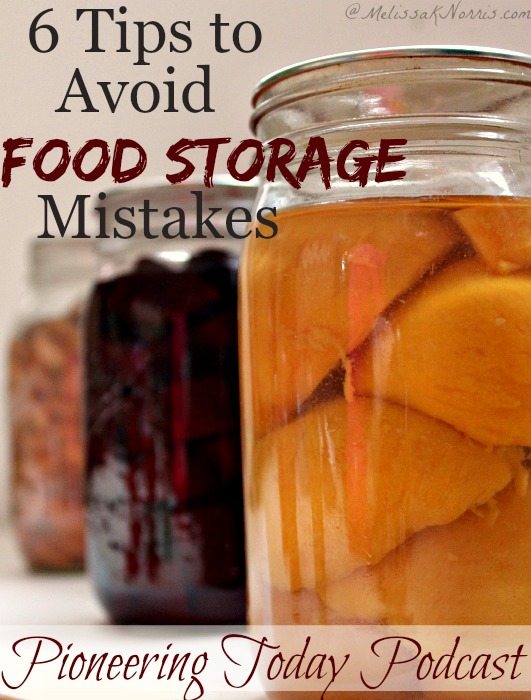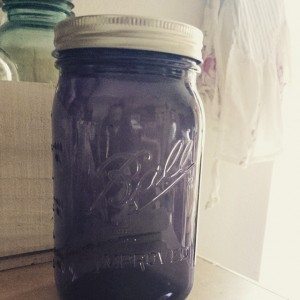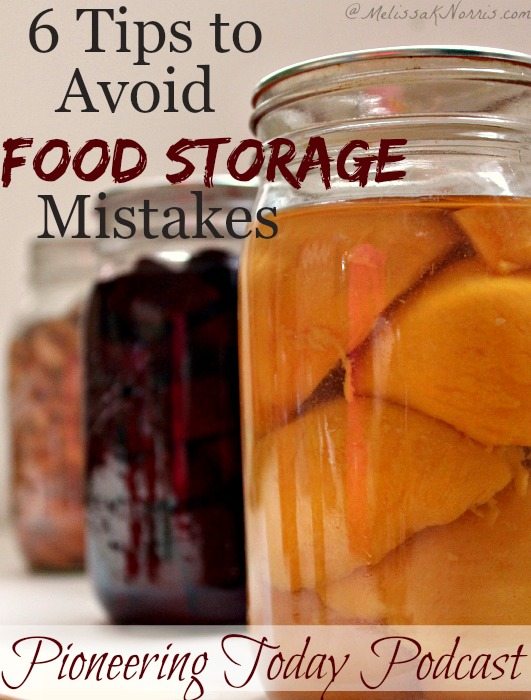Use these 6 tips to avoid food storage mistakes in week 2 of our Spring Cleaning challenge.

Want to know one of the costliest mistakes in food storage? American’s throw out more than $165 billion dollars in food every year. In one year.
That amount is staggering. And I’m willing to bet if you and I were honest, we’ve thrown out more food than we’d like to admit. One of the things I love most about the pioneering today mindset is doing more with less, being wise stewards with what we have, and always looking to do better.
I post new episodes on Friday mornings. You can subscribe via RSS and receive every episode for free. ![]() Or subscribe via Itunes
Or subscribe via Itunes
Unless you’re going to the grocery store every day, everyone has some sort of food storage in their home. I personally try to only go shopping once a month. Our food storage consists of our own homegrown beef, chicken, pork, and lots of canned good from our garden. However, we don’t grow all of our own food so I recommend everyone start with these 8 Foods Everyone Should Be Storing and How.
It’s important to keep your food storage organized. If you can’t find or see what you have at a glance you’re likely to either let it go unused or to purchase more before you need it.
6 Tips to Avoid Food Storage Mistakes
First thing is to go into your pantry or where you keep your food storage and look at the shelves. Can you immediately see your food or do you have to move things out of the way? If you have to move things, it’s time to reorganize.
1. Keep like items together. I keep home canned goods together in one area. I can tell at a glance how many jars of each food item I have left. My flour is all on one shelf, same with sugar, herbs, and pasta. My wheat berries are kept in bags and buckets, all together in one spot.
Take all of the times off of shelves and wipe down the shelves. Clean up any spills. Put items back on the shelves by category and date.
2. Keep track of dates. If the item doesn’t have an expiration date on it already, make sure you have the date it was either canned or purchased written somewhere easily read. You may think you’ll remember, but trust me, you’ll likely forget. I put the year on the top of all of my canning jars. The exception to this is the re-usable Tattler lids. I put those jars at the front so they’ll be used first. You could also write in sharpie on the outside of the jar as it will wash off with a good scrubbing later.
3. Practice food rotation. Always put the oldest item in the front to be used next. Whenever you get a new item in, make sure you rotate it to the back. This way, you’ll always be using the oldest first. This is as important in your food storage and pantry as it is in your fridge.
4. Never stock what you’re not using. One of my biggest beefs with food storage advice is to stock foods you’d never eat in your every day life. I know a lot of people have food storage as part of their preparedness plan, but what if the day you’re preparing for never comes? Then you’ve wasted money on things you’re not using. Plus, if you’re not using them, when that day comes you need to, will you even know how?
I only have items in my food storage that I’m using in our every day cooking and life. I don’t have the extra funds or money to invest in things I’m not going to be cooking and using on a regular basis. If you stock an item, then you best be using it in my book.
5. Know what you have. One of the easiest ways to loose money is to not know what you have. For example I thought I only had ten pounds of sugar left in our food storage so I purchased another ten pounds when I went to the store…. now I have thirty pounds of sugar because I hadn’t double checked. That’s close to a year’s worth of sugar for us. I don’t use a lot in our day to day cooking and all of my jam and jelly recipes are low sugar. That sugar won’t go to waste, but I actually needed to replenish my spelt berries and could have used the money for that instead of the sugar.
Keep an inventory of your food storage so you know when to replenish your stock and what you’re low on.
6. Know how much of an item you use in a year. Our goal is to have one year’s worth of food in our food storage. Each family is going to be slightly different. Easiest way to calculate a year’s supply worth of food: Put a date on an item when you open it and see how long it takes you to use it up, then multiply that out for 12 months. Be sure to account for holidays or preserving times when you may use more of a certain ingredient like canning salt or sugar.
I recommend restocking an item before it’s totally gone. I keep a minimum of sugar, flour, wheat berries, salt and coconut oil on hand at all times. That way I’ll never be out but I’m not restocking it all at the same time.
Find a place for all of your canning bands. I don’t store my home canned goods with bands on as they tend to rust. I have a large basket I keep most of the bands in but you can as creative as you like. I’ve seen canning bands hung on a rope.
Look at your canning lids. I try to keep a year’s worth on hand, so that’s about two hundred lids. Make sure you have enough regular and wide mouth lids to fit your supply of jars. Speaking of jars, did you run low last year? I try to can more than I did the year before. I tend to run lower on quart sized wide mouth jars than any other size. Now is a good time to stock up before the craziness of canning season arrives.
I love vintage Mason jars. I have several old turquoise ones that I use for storing dry goods and as decoration. I even use one as a toothbrush holder in my kid’s bathroom. The turquoise jars were made for a number of years, but other colors are more rare, such as green, purple, and even black.
The darker colored glass was to keep light away from the food. Black is extremely rare and I’ve never seen one.

Ball canning started a limited edition of remakes and released the blue and green jars last year. This year the have purple and it is the last year and color they’re releasing. I got mine yesterday and I have to say, the purple maybe my new favorite. It’s a really pretty deep purple and in the light a violet color. I can’t wait to put some pink roses in it this summer and I’ve got some homemade goody ideas for them as well.
The rep from Jarden (Ball canning) said stores should be getting them soon, but they put them out on their own time line. If you want to make sure you get some, or are like me and can’t wait, here’s where to order the new limited edition heritage purple Mason Jars. P.S. at the time of posting they were on sale!
Go through your spice and herb cabinet. We all know spices and herbs loose their potency after being exposed to air. Spices and herbs can make or break dish. They’re an excellent way to add flavor with little cost.
I don’t purchase spices at the store. They’re too expensive. I grow some of our own herbs at home (how to dry and store your own herbs) but with our climate I can’t grow all of my own herbs and certainly not all of my own spices.
Go through your spice cabinet and toss any really old herbs and spices. You know you’ve got some.
I have a basic list of spices and herbs I always have on hand. This is especially important if you plan on making all of your own spice mixes like I do.
Spices- Cayenne pepper, chili powder, cumin, celery salt, cloves (whole and ground), curry, ceylon cinnamon, ginger, mustard (whole and ground), nutmeg, red pepper flakes, pepper (whole and ground), paprika, tumeric, onion powder, and garlic powder. Note: I generally use the whole versions of these spices in my canning recipes.
Herbs- basil, dill, oregano, sage, thyme, rosemary, and parsley

I purchase my herbs and spices in bulk from Mountain Rose Herbs. They have organic, non-GMO, and harvested responsibly herbs and spices. Plus, they’re much cheaper than store bought versions. Organic spices at stores near me are usually well over $5 for one small bottle, but at Mountain Rose Herbs bulk section I can get an entire pound of organic garlic powder for $10, or a regular small bottle for just $3.25.
And their smoked sea salt and smoked paprika… I have a thing for smoked foods, what can I say?
Reader Question of the Week:
“What is the best pressure canner to buy?”
Answer: It depends on a several factors which vary for each family. This is one of my favorite questions to answer because it means someone is getting into canning. Here are my 5 tips to purchasing the best pressure canner for you.
Verse of the Week
Time is so fleeting. As the days seem to pass faster and faster, I reminded we aren’t guaranteed anything beyond today. I want to live each day in step with the Lord. Take time every day to ask the Lord what He would have me do and to rest in His presence.
Teach us to number our days aright, that we may gain a heart of wisdom. Psalm 90:12



